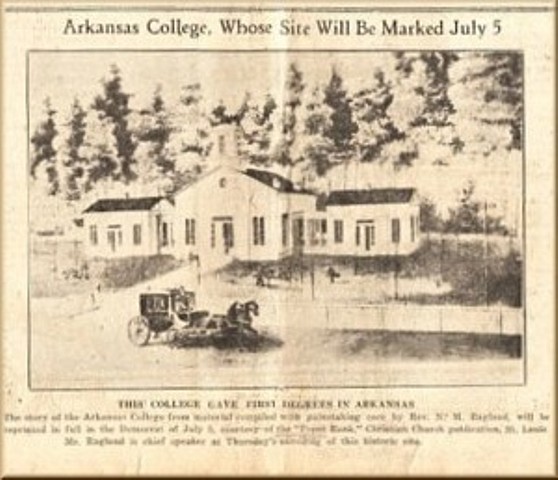| |
Fayetteville Incorporated in 1836
Fayetteville's incorporation,
under her present name, was approved according to a copy of the act in
possession of Former Postmaster Hugh Reagan-November 3, 1836. The act is
signed by John Wilson, speaker of the House, and Sam C. Roane, president
of the Senate, also by J. S. Conway, a member of one of Arkansas'
earliest distinguished families.
Boundaries were: Section No. 16 in Township Number 16,
north, range Number 30 west, in the County of Washington. And all white
male inhabitants 21 and over were made "a body politic and corporate by
the alderman and town council of Fayetteville." One alderman and five
members of the town council were specified as governing body, to be
elected the first Monday in each year. Citizens were made exempt from
working roads but were required to work on the streets.
==========*============
Rebecca Washington, wife of General Washington brother's
son and great-grandmother of Miss Sue Walker, Vol Walker, Wythe Walker
and David Walker, moved to Fayetteville in 1836. |
|
Piano of 1830 Lent to
Museum The French piano maker who back about 1830
sawed out the wood for a little baby grand upright piano of rosewood did
not know that he was building an instrument not for the parlours of
madame in France, but for those of a general of the barbarian democracy
of the West. Nor did he know that after the great civil
conflict that tore apart this nation in 1861-1865 this general was to
carry this same rosewood piano with him to a pioneer state called
Arkansas, where transportation development demanded that the last part
of the journey be made by team over the shaggy backs of the Ozarks.
And least of all did he suspect that nearly 100 years later this piano,
now the property of Mrs. Lena Sharp at a town called Fayetteville, would
be on display in the historical museum for the same town's celebration
of its hundredth birthday. The piano was brought
here in 1878 by General D. H. Hill, when he came here from North
Carolina to assume the chair |
|
of the president of the University of Arkansas, then
called Arkansas Industrial University. In 1882 A. B. Lewis, father of
Mrs. Sharp, purchased the instrument, along with other household
furnishings. An account book dated 1860 which belonged to
Mr. Lewis, also will be on display at the museum, as will another
account book from Cane Hill and dated 1832. This was given to Mr. Lewis,
on of the city's early merchants, and now is owned by Mrs. Sharp.
Eight government grants, dated 1835 and 1836 for 700
acres of land and signed by President James Buchanan, will be on
display. These are made to Nelson Hewitt, grandfather of Mrs. Sharp, and
are for a tract of land near the present site of Johnson.
A group of early iron work, a pair of forger's tongs, a
broad-axe, an iron tiptkin, and a pair of crane hooks, brought here from
Virginia by Mrs. Sharp's mother, Mrs. Joseph Lewis, are to be furnished
the museum by Mrs. Sharp.
|
|
There follows a list of additional things
to be lent to the museum by Mrs. Sharp. A camphor bottle
which belonged to her mother, Rebecca Hewitt, and given her by her
mother, Mrs. Nelson Hewitt, about 75 years ago by Mrs. Clint Hill,
Governor Yell's daughter-in-law.
A sliver butter knife brought from Tennessee, from 75 to 100 years old.
A daguerreotype of A. B. Lewis in Confederate uniform.
A daguerreotype of Sidney Battle, the roommate of A. B. Lewis when
both were in Arkansas College. Sidney Battle was brother of Judge Battle
of the Arkansas supreme bench.
A case of Confederate money which belonged to Nelson Hewitt.
A picture of the Hawthorne school at Farmington taken in 1842. This
school is among the oldest of the county.
Two fruit bowls, one 73 and one 58 years old.
A basket, the property of Mrs. Sharpe's grandmother Hewitt, which is
65 years old. |

